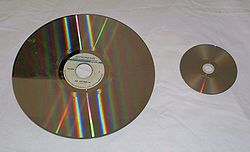
Laserdisc Wikipedia
Laserdisc (LD) was the first commercial optical disc storage medium, and was used primarily for movies for home viewing.
During its development, MCA, which owned the technology, referred to it as the Reflective Optical Videodisc System; changing the name once in 1969 to Disco-Vision and then again in 1978 to DiscoVision (without the hyphen), which became the official spelling. MCA owned the rights to the largest catalog of films in the world during this time, and they manufactured and distributed the DiscoVision releases of those films under the "MCA DiscoVision" label beginning on December 15, 1978.

Laserdisc (left) compared to a DVD/CD (right).
Pioneer Electronics also entered the optical disc market in 1978, manufacturing players and printing discs under the name Laser Videodisc. For 1980 the name was compressed into LaserDisc and in 1981 the intercap was eliminated and "Laserdisc" became the final and common name for the format, supplanting the use of the "DiscoVision" name, which disappeared shortly thereafter; titles released by MCA became MCA Laserdiscs or (later) MCA-Universal Laserdiscs. The format has been incorrectly referred to as LV or LaserVision, although this actually refers to a line of Philips brand players; the term VDP or Video Disc Player was a somewhat more common and more correct name for players in general.

During the early years, MCA also manufactured discs for other companies including Paramount, Disney and Warner Bros. Some of them added their own names to the disc jacket to signify that the movie was not owned by MCA. When MCA merged into Universal years later, Universal began reissuing many of the early DiscoVision titles as MCA-Universal discs. The DiscoVision versions had largely been available only in pan and scan and had often utilized poor transfers, the newer versions improved greatly in terms of both audio and video quality.
Hiç yorum yok:
Yorum Gönder